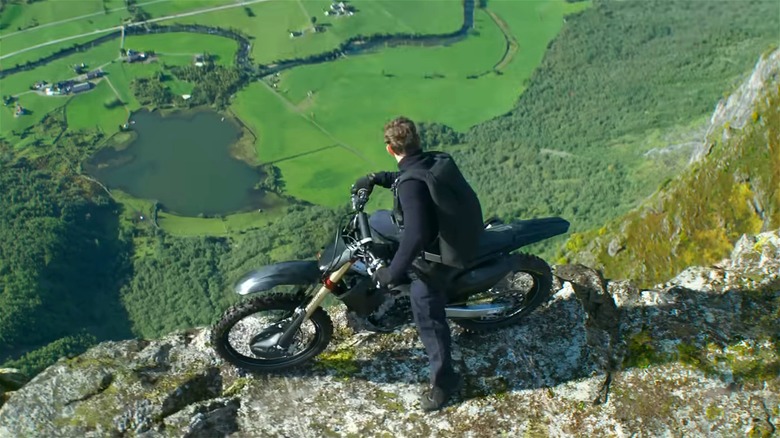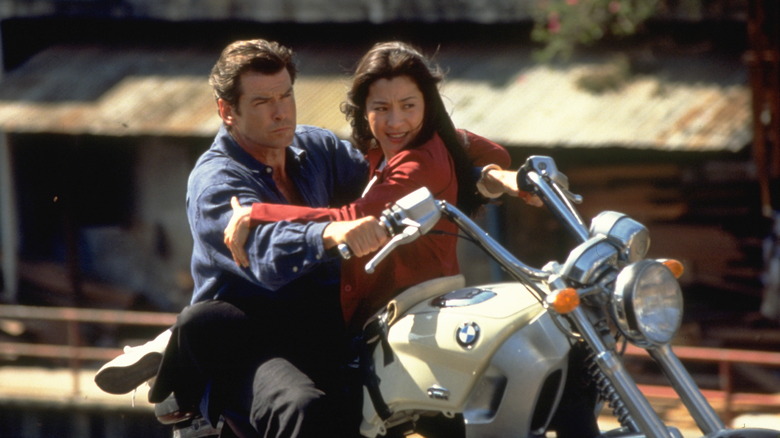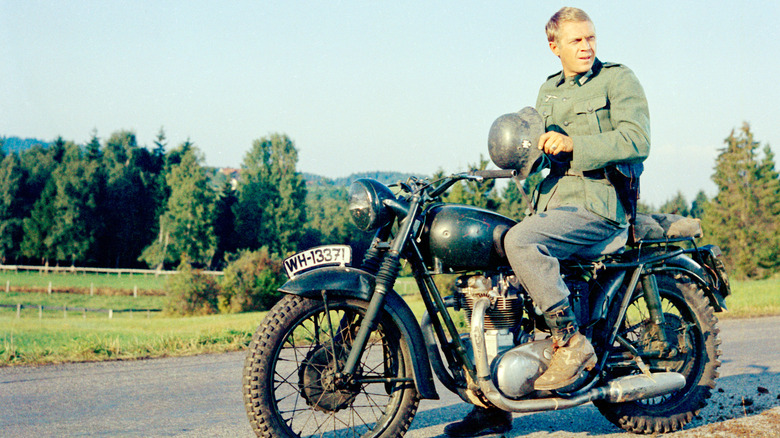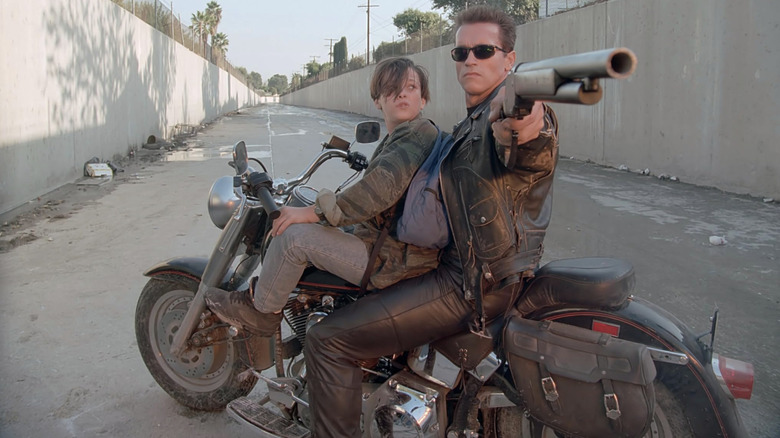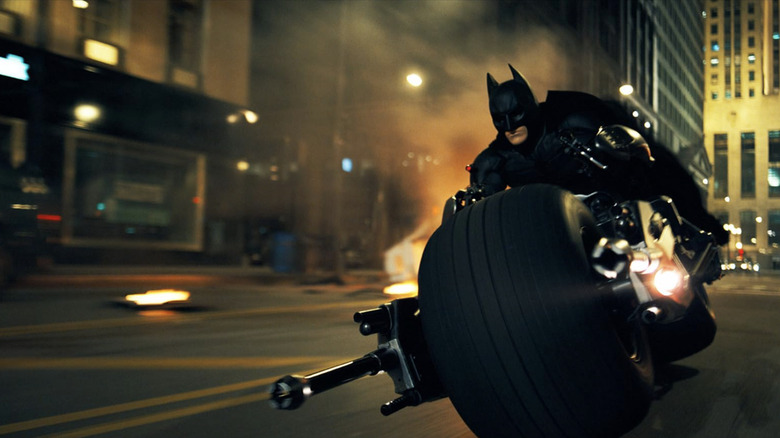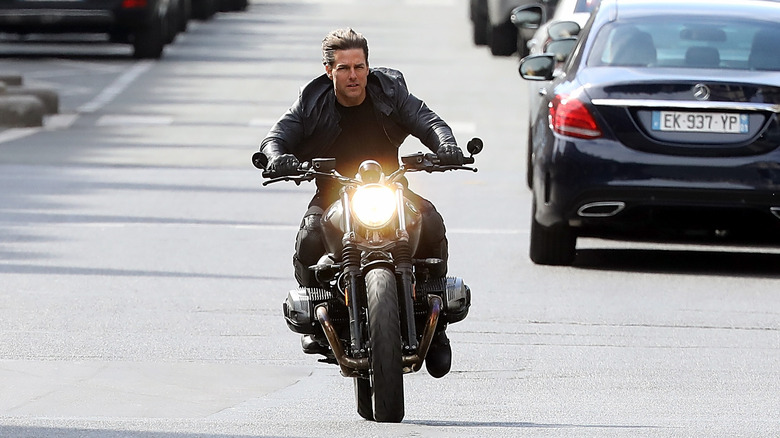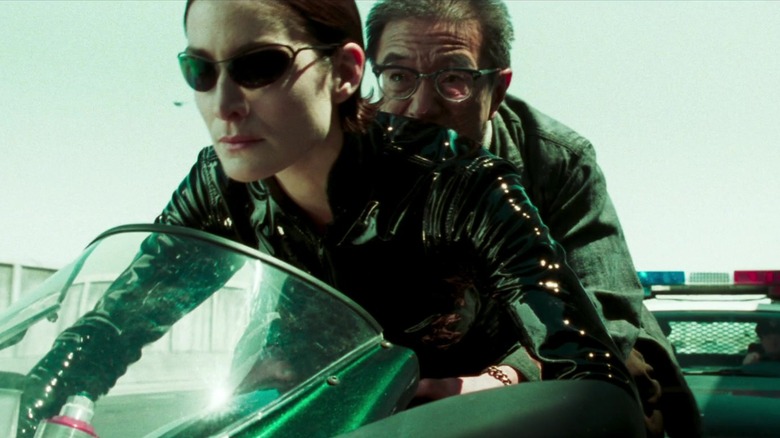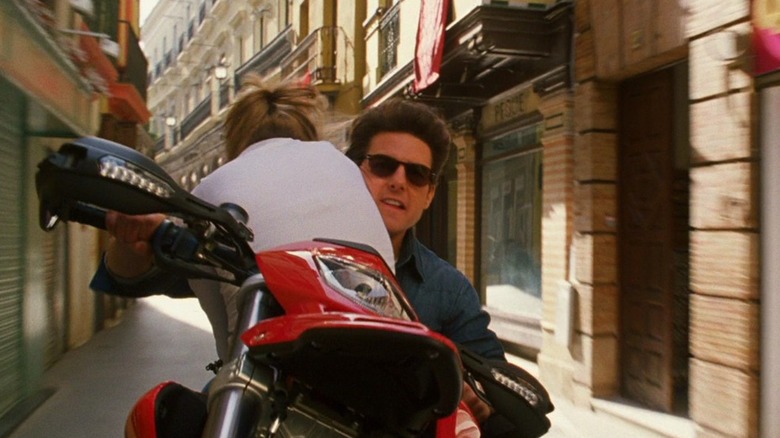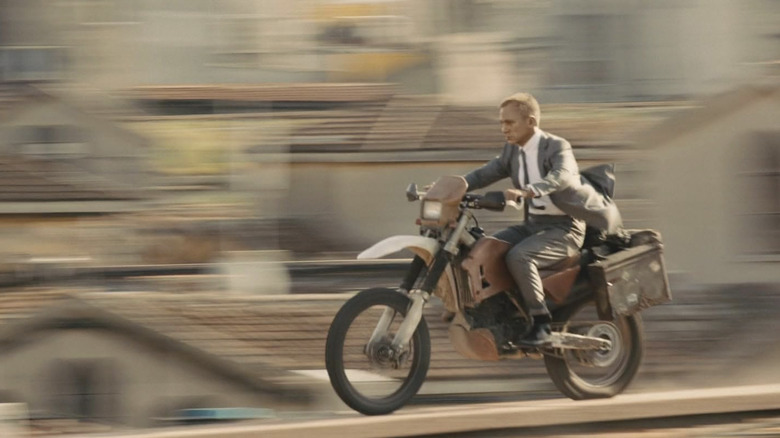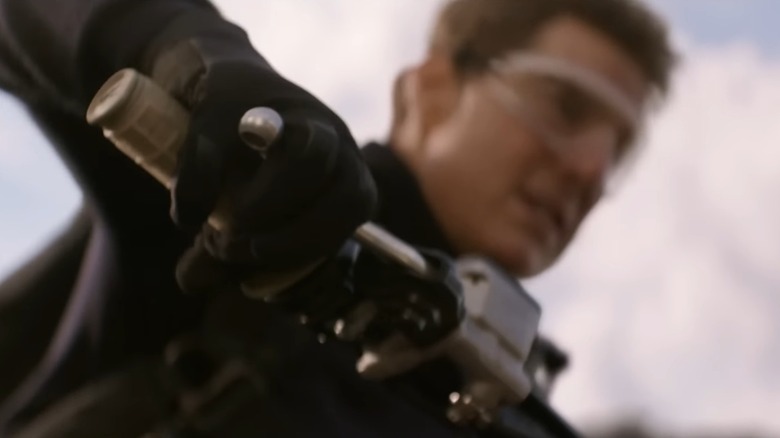The 10 Most Impressive Motorcycle Stunts In Movies
Motorcycles have featured in movies since 1905's "A Motorbike Adventure" – released only ten years after the Lumiere brothers captured the first film on celluloid — and have been to action flicks as a means of providing high-octane entertainment ever since. From early stars of the silver screen like Buster Keaton and Marlon Brando to contemporary actors like Keanu Reeves and Tom Cruise, many have used the motorcycle to showcase their action chops. Of course, it is often the stunt performers that should take most of the credit.
While car stunts are fundamental to the Hollywood thriller, the spectacle is often kicked up a gear when it comes to motorcycle stunts due to an increase in the perceived risk factor and the high speed and maneuverability of the two-wheeler. This flexibility lends itself to many exciting scenarios, including riding up or down steps, into oncoming traffic, along rooftops, performing unbelievable jumps, and navigating tight spaces at high speeds.
Motorcycles have been the basis for many memorable movie moments that have got our adrenaline flowing over the years and have helped embellish the careers of many actors, directors, and stunt performers throughout cinematic history. Here are our picks for the most impressive motorcycle stunts to feature in the movies, taking into account their staging, execution, and, most importantly, their thrill factor.
Tomorrow Never Dies
In the second installment of the James Bond franchise with Pierce Brosnan at the helm, Bond and Wai Lin (Michelle Yeoh) handcuffed together on a hotwired BMW R1200C touring bike in Ho Chi Minh City, Vietnam. This is a remarkable machine even by today's standards. However, a 125cc Honda motor scooter would have been far more realistic, given the location, as German imported motorcycles were a rarity in 1997 Saigon.
This motorcycle stunt is ambitious as it not only involves a pillion passenger but she is cuffed to Bond, meaning that she initially has to operate the clutch while James provides throttle and shifter duties, a feat that would be near impossible in real life. They race through Ho Chi Minh City's busy markets, pursued by goons in SUVs while dislodging various goods in an effort to stop them, including ignited fireworks, before jumping over a street and crashing through a roof. Soon, a chopper carves the street up with its rotors at a pitch of 45 degrees, but Bond and Wai Lin disable the helicopter after sliding the bike beneath its rotors in a wonderfully over-the-top move.
While the scene is implausible, to say the least, it is typical of the overblown and tongue-in-cheek nature of the 1990s Bond films and is nonetheless impressive. It was also highly ambitious, as evidenced by the fact that multiple motorcycles were destroyed in the process.
The Great Escape
"The Great Escape" has maintained its status as a cult classic, largely because it is so much more than just a war movie. It's also a buddy movie and a reverse-heist movie with an exciting breakout, an ensemble cast, stunning locations, a great score, and some memorable pursuit sequences once the team makes its daring dash for freedom.
Chief among these is Steve McQueen's exciting scenes as his character, Hilts, is chased across the Bavarian Alps. McQueen commandeers a Triumph TR6 made to look like a German military BMW after running a snare wire across a road. He is pursued by many German soldiers on motorcycles and in sidecars, which proves to be a perfect showcase for McQueen's not-inconsiderable biking skills. Yet for the set piece, the motorcycle is handed over to the star's stuntman and double, Bud Ekins, for the daring leap over a wood and barbed wire barrier before Hilts is finally caught by the Germans right on the Swiss border.
While the chase itself was worked into the script by McQueen and director John Sturges, partly to satisfy the star's desire to ride fast machines against the studio's wishes, it formed a satisfying sequence that helped consolidate the film's final scenes. As for the motorcycle leap over the barbed wire fence, it has become synonymous with the movie itself, helping to cement its reputation as one of the greatest war films of all time.
Terminator 2: Judgement Day
The long-awaited sequel to 1984's "The Terminator" did not disappoint when it arrived in 1991. In the early stages of "Terminator 2: Judgment Day," John Connor (Edward Furlong) is chased on a Honda XR dirt bike by the shape-shifting T-1000 cyborg (Robert Patrick) driving a very robust Freightliner truck. In a reversal of roles, Arnold Schwarzenegger plays the good guy Terminator, who, in turn, pursues the T-1000 on a Harley-Davidson Fat Boy.
As the Freightliner first leaps off a bridge onto the dry bed of a spillway, Connor does the best that his diminutive 50cc steed will allow to evade his assassin but is flagging fast. The Terminator destroys a gate lock with a nifty single-handed shotgun blast and pursues from above, ultimately swinging onto a high retaining wall. He leaps from the wall before pounding the spillway floor in a shower of sparks. Gary Davis, the stunt coordinator for this scene, explains that the Harley was suspended on wires between two cranes to add control and slow the impact. Director James Cameron then removed these in post-production using cutting-edge computer editing techniques.
In this scene, stuntman and Schwarzenegger double Peter Kent sat in for the giant Austrian, as is common when performing dangerous sequences like this. Ultimately, it became one of the most memorable scenes in an already action-packed movie, which grossed over half a billion dollars, placing Cameron firmly in the big league of Hollywood directors.
The Dark Knight
Having since been played on the silver screen by Ben Affleck and Robert Pattinson, it's easy to forget just how groundbreaking and sinister Christian Bale's portrayal of Batman was when the movies were first released. Christopher Nolan's vision eschewed the comic book aesthetic that seemed to follow Tim Burton's whacky creation and Joel Schumacher's largely forgettable attempts, making the Caped Crusader more human, more fallible, and more believable.
While "Batman Begins" was a worthy introduction to the reborn franchise, "The Dark Knight" took it up a notch, buoyed by an unforgettable Heath Ledger as the Joker. One stand-out set piece was the Bat Pod motorcycle chase that proved to be highly complex, both in its staging and the fact it was rendered in the 5.6K Imax resolution. While the visual effects were difficult to edit, the results are staggering.
The Bat Pod is a motorcycle that is ejected from the Batmobile after it is wrecked, emerging phoenix-like from the ruins to pursue the Joker and his henchmen driving a 40-foot tractor-trailer along a dark Gotham highway (actually Chicago's Lower Wacker Drive). The truck is ultimately totaled, flipped onto its back on La Salle Street in a highly ambitious stunt.
This complex scene was almost entirely filmed in situ, and the only casualty from the entire sequence was an IMAX camera that was destroyed in the process. Christopher Nolan's iteration of the Batman Saga is arguably the best, and scenes like the chase involving the two-wheeled Bat Pod helped bolster its stellar reputation.
Mission: Impossible — Fallout
The "Mission: Impossible" franchise has become a mainstay of the action film genre and is renowned for its stunts that showcase Tom Cruise's penchant for anything that revs. The fact that he performs most of the stunts himself (under the watchful eye of stunt coordinator Wade Eastwood) is remarkable and must have made the movies' producers and financiers lose more than a bit of sleep during production.
The chase scene in "Mission: Impossible — Fallout" exemplifies how a motorcycle is so much more versatile than a car when performing action sequences. While each has its own merits, there is no way that a car could have executed the same pinpoint-accurate maneuvers through the streets of Paris, winding through subways, alleys, and busy streets while also spinning on a dime to evade the Gendarmerie, which is also on motorcycles. This is evidenced by the fact that many of the stunts had to be shot via a bike-mounted Steadicam.
The sequence in question finds Ethan Hunt (Cruise) commandeering a BMW R Nine T motorcycle. Having ridden at high speed into oncoming traffic, he descends into a subway and emerges into yet more congestion in a perfectly choreographed scene, as cars collide and swerve all around. He ends up circling the Arc de Triomphe in the wrong direction (stunt drivers drove all vehicles), where our protagonist exits and slams into the side of a passing car. The entire scene is only around four minutes long, yet it stands out as one of the most memorable sequences in a film that, for many, was the highlight of the entire franchise so far.
The Matrix Reloaded
The "Matrix" franchise rewrote the rule book on how action sequences are performed, with slow-motion, circular-sweeping camera techniques that immerse the viewer in the scene, resulting in a heightened-reality experience. Carrie-Anne Moss is pivotal as Trinity, a computer hacker who escaped from the Matrix and is assigned to train Neo, played by Keanu Reeves.
In "The Matrix Reloaded" Trinity and her accomplice, the Keymaker, leap off an overpass onto a speeding trailer transporting motorcycles, among them a jet-black Ducati 996. Unsurprisingly, the Keymaker has a key for the vehicle, and they both mount up and jump off the front of the transporter truck before winding between traffic on the busy freeway. In what could have been the inspiration for the "Mission: Impossible Fallout" chase scene, they must perform a (nicely executed) 180-degree spin and ride headlong into oncoming vehicles while being pursued. The Keymaker is then grabbed and swung onto a moving truck by Morpheus as Trinity makes her getaway.
This scene is all the more impressive when you learn that Carrie-Anne Moss had never ridden a bike before and underwent immersive training prior to shooting, overcoming a fear of motorcycles as she did so. Any biker could tell you that to be a complete novice and be expected to master a Ducati 996 would be daunting. Yet, the stunt sequence is perfectly executed and embellished by the use of camera angles that pass under, around, and over moving vehicles in typical "Matrix" style.
Knight and Day
While 2010's "Knight and Day" may not have been one of the most memorable action flicks to feature Tom Cruise, it served as a worthy summer blockbuster that showcased the tongue-in-cheek comedic talents of him and his co-star Cameron Diaz. At one point, the unlikely pair of spies wind up riding a motorcycle, in this case, a Ducati Hypermotard, while being pursued through the streets of Seville in Spain (confusingly, also shot in Cadiz while the annual Running of the Bulls takes place).
At this point, one has to question whether Cruise insists on there being a motorcycle involved in the films he stars in, as this is yet another frivolous, albeit highly entertaining, sequence that mirrors "Tomorrow Never Dies" in a high-speed chase, where the pillion must sit facing backward on the fuel tank while shooting at the enemy. They end up surrounded by stampeding bulls and speeding through the packed bullring before performing jumps, wheelies, and zipping between two trams in a perfectly timed stunt to end the sequence.
Unlike most of Cruise's action movies, "Knight and Day" never spawned a sequel. To make one could have oversaturated the star, as he had already been involved in many projects that showcase his action chops, not least the "Mission: Impossible" saga that is still ongoing. Yet, as a standalone stunt sequence, you cannot ignore the motorcycle chase in "Knight and Day" as an ambitious and well-executed performance, made more difficult with the addition of a pillion passenger.
John Wick: Chapter 3 – Parabellum
By now, we have seen that motorcycle chases are perhaps overused in action sequences, and it must have been difficult for the creators of "John Wick: Chapter 3 – Parabellum" when trying to come up with something unique to bring to the table. What resulted was a motorcycle-borne samurai swordfight with sweeping camera angles that wouldn't look out of place in the star Keanu Reeves' "Matrix" franchise. This must have quenched his thirst for serious two-wheel action as a known bike fanatic and co-founder of the Arch Motorcycle company.
Unlike most motorcycle action sequences, this scene combines the usual chase and gunfight scenarios with hand-to-hand combat, making this all the more ambitious and requiring heavy use of green screen effects. While some may argue lessens the accomplishment, the scene garners some staggering results. The riders themselves were perched on sled rigs for much of the sequence, which was heavily choreographed, rehearsed, and performed in a greenscreen-equipped warehouse. The motorcycles and the backdrop of the Verrazano-Narrows Bridge were then digitally added afterward in what is a masterclass in VFX editing.
Ultimately, to have performed this stunt in real life would have been not only several degrees more challenging, but it could have been prohibitively dangerous. While the use of puppeteers, dummies, and CGI may go against the traditional stunt performance grain, the motorcycle fight in "John Wick: Chapter 3" is undeniably brilliant and the result of many technological, practical, and theoretical practices combined.
Skyfall
As anyone who has ever ridden a dirt bike will attest, they are very different animals from the standard motorcycle. The rider is seated at around 35 inches off the ground on a lightweight and skinny machine with huge ground clearance, large, knobby-tired wheels, masses of torque, and plenty of pep to take you anywhere off the beaten track. In the case of the James Bond film "Skyfall," this means over the rooftops of Istanbul's Grand Bazaar.
The initial scenes in Bond movies are always high on octane and adrenaline, but this motorcycle chase over Turkey's largest city sees Daniel Craig's Bond steal a dirt bike in hot pursuit of an enemy of the Crown in one of his most memorable openers yet. The two go-anywhere machines end up ascending some steps before appearing high above Istanbul on a terracotta-tiled maze of rooftops with the stunning Hagia Sophia mosque as a backdrop. Incidentally, both bikes are faithful Honda CRF 250s which have been dressed to look like local vehicles.
Filmed by veteran cinematographer Roger Deakins over the course of a few weeks, the scene combined practical elements shot in situ, with green screen close-ups and helicopter camerawork to enhance the scope of this set piece. Changing weather and tricky logistics hampered the shoot, but it came together seamlessly. While CGI may have changed how stunts are performed going forwards, this is a good example of how practical and digital effects can be combined to achieve excellent results.
Mission Impossible: Dead Reckoning Part One
No motorcycle stunt has ever been as ambitious as the one executed during the production of "Mission Impossible: Dead Reckoning Part One." A short showing the making of the stunt was played as a trailer for the film before its release, and to sit in the theater, the audience's collective feeling of awe and disbelief was palpable. It involved Tom Cruise riding a custom-made Honda CRF 250 off a 4,000-foot cliff in Helsetkopen, Norway and freefalling into a rock bowl before activating his parachute.
Before even setting foot in Norway, the stunt team practiced for months, first by performing over 13,000 motocross jumps and 5,000 skydives before making several dummy jumps in a quarry in Oxfordshire, U.K., to compute an algorithm for the final stunt. Once in Norway, a ramp had to be built to give Cruise the required trajectory to execute the jump that was later removed using CGI. All building materials had to be flown in by helicopter, including a makeshift studio and command center where director Christopher McQuarrie and members of the production team viewed the camera and drone footage.
The Honda CRF 250 is often referred to by enthusiasts as indestructible, however, no fewer than six bikes were destroyed in a single day while filming multiple takes. Ultimately, Tom Cruise trumped all his previous two-wheeled exploits when he conceived this incredible stunt, as he seems to be on a mission to make action sequences a little less impossible with each subsequent chapter of the franchise. One can only wonder what he will attempt next, but it is a safe bet that motorcycles will be involved in one way or another.
